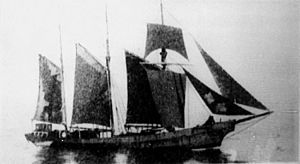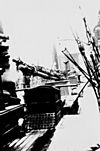Mary B Mitchell (schooner) facts for kids
 |
|
Quick facts for kids History |
|
|---|---|
| Name | Mary B Mitchell |
| Owner | Jones, Preston, Lord Penrhyn, William Thomas, Royal Navy, Job Tyrrell, James Tyrrell |
| Port of registry | Anglesey, Dublin |
| Builder | Paul Rogers, Carrickfergus |
| Launched | 1892 |
| Commissioned | 1893 |
| In service | 1893-1944 |
| Fate | Wrecked 14 December 1944 |
| General characteristics | |
| Tonnage | 227 gross tons |
| Length | 129' 7" |
| Beam | 24' 4" |
| Depth | 10' 8" |
| Propulsion | sail + auxiliary motor |
| Armament |
|
| Notes | motor & armaments fitted 1916, disarmed 1919 |
The Mary B Mitchell was a famous ship known as Mary B. She started as a British ship and later became Irish. This amazing schooner had many lives! She was a fancy yacht, a brave warship, a working cargo ship, and even a movie star. She carried important goods through dangerous waters during wartime.
Built in 1892, she first carried slate from Wales. Later, she became a luxury yacht and sailed the Mediterranean Sea. She then went back to carrying cargo like china clay. During World War I, she was used as a special "Q-ship" to trick enemy submarines. After the war, she joined the Arklow fleet and sailed the Irish Sea for many years. In the 1930s, she appeared in several films. Even after being retired, she was called back into service for World War II. Mary B. helped bring vital food to Britain and coal to Ireland. Sadly, she was wrecked in a storm in December 1944.
Contents
Mary B Mitchell: Her Early Days
The Mary B Mitchell was built in 1892 by Paul Rogers in Carrickfergus. She was a type of sailing ship called a three-masted topsail schooner. This means she had three masts and special sails at the top.
She began her life carrying slate from North Wales to Hamburg, Germany. For a while, she was owned by Lord Penrhyn. He used her as a fancy yacht. After that, she became a coaster, which is a ship that carries goods along the coast. She transported china clay from Cornwall, England.
Mary B. as a War Hero in World War I
During World War I, the British Navy needed clever ways to fight enemy submarines, called U-boats. In 1916, three schooners from Arklow, Ireland, were taken over by the Navy. These ships were the Cymric, Gaelic, and Mary B Mitchell. They were turned into "Q-ships."
What was a Q-ship?
Q-ships were regular-looking merchant ships that secretly carried hidden guns. Their job was to pretend to be easy targets for U-boats. When a U-boat came close to attack, a small "panic party" would pretend to abandon the ship. This was a trick to make the U-boat think the ship was empty. Then, the hidden gun crews would surprise the U-boat and try to sink it.
The Mary B. became a Q-ship in April 1916. She was armed with a 12-pounder gun, two 6-pounder guns, and two machine guns. She started her first patrol in June 1916.
Mary B. and U-boat Encounters
The Mary B. Mitchell reported several battles with U-boats. In June 1917, her crew claimed to have sunk two U-boats. However, after the war, experts looked at the records. They found that none of the Mary B. Mitchell's fights actually resulted in a U-boat being sunk. Even so, these stories were very popular in newspapers at the time. Her captain, Lawrie, even received a special medal.
After the war, it was decided that Q-ships were not as effective as first thought. They used up many skilled sailors but didn't sink enough U-boats to make it worthwhile. Sadly, one Arklow Q-ship, the Cymric, did sink a submarine. But it was HMS J6, a British submarine, in a tragic accident.
Mary B. Between the Wars
After World War I, the Mary B Mitchell was no longer a warship. She was sold to Captain Job Tyrrell in Arklow, Ireland, in March 1919. She became known as an "Arklow schooner." A new diesel engine was put in, which helped her sail even when there wasn't much wind. For the next twelve years, she worked hard, carrying goods across the Irish Sea.
Mary B. the Film Star
In 1934, the Mary B Mitchell got a new job: acting! A film company hired her to appear in several movies.
She played the famous ship Mary Celeste in the film The Mystery of the Mary Celeste. This movie was released in the U.S. as Phantom Ship in 1935. It was one of the early films from the famous Hammer Film Productions. She also appeared in the 1936 film McGlusky the Sea Rover, which was called Hell's Cargo in the U.S.
Mary B. in World War II
When World War II began, Ireland had only 56 ships registered, and 14 of them were Arklow schooners. These schooners were incredibly important for keeping Ireland supplied with goods. The Mary B. Mitchell carried food exports and wood props to Wales. She would then return to Ireland with important cargoes of coal.
The Dangerous Lisbon Run
In 1943, Mary B. started making very risky trips called the "Lisbon run." American ships would not enter Irish waters during the war. So, they brought goods meant for Ireland to Lisbon, Portugal. Ships like the Mary B. Mitchell had to go to Lisbon to pick up these vital supplies.
Britain had declared the Bay of Biscay a "danger zone" to stop supplies from reaching Germany. However, Britain also needed to export coal to Portugal to earn money. To help ships pass safely, special "Navicerts" were created. Ships with a navicert were allowed to travel through Allied lines. They had to follow a specific path in the ocean. It was very hard for sailing ships to stay on this straight line, especially in the stormy Bay of Biscay.
The Mary B. Mitchell made five of these dangerous voyages. She carried food to Britain, then British coal to Lisbon, and finally brought American goods back to Ireland. Her crew, including Captain Patrick Brennan, bravely survived these trips. Another Arklow schooner, the Cymric, which had also been a Q-ship in World War I, was not as lucky. She disappeared with all her crew.
Final Voyages and Loss
In April 1944, Britain stopped issuing navicerts as they prepared for D-day. At this time, Ireland faced a severe shortage of fuel. The government asked the Arklow schooners to focus only on importing coal. These ships helped prevent a very difficult winter for Ireland. By autumn, they had brought in 40,000 tons of coal, while also taking food supplies to Britain.
The Mary B. Mitchell left Dublin for the last time on December 13, 1944. She was heading to Cumberland with a cargo of burnt-ore and was supposed to return with coal. A terrible storm hit, and she was driven onto rocks at the entrance to Kirkcudbright Bay. The ship was lost. Captain Patrick Brennan and his crew of eight were rescued by the Kirkcudbright lifeboat, and everyone survived. Some items from the ship are now on display in the Stewartry Museum. You can still see some wreckage at the bottom of the cliff near Senwick Church.
Remembering the Mary B Mitchell
The Mary B Mitchell is remembered in Bangor, Wales. There is a memorial plaque and a bronze weathervane in the city's shopping area. The weathervane shows her shape, and the plaque tells her story.
See also
- Cymric Arklow Schooner
- MV Murell Arklow ship
- MV Tyrronall Arklow Schooner
- James Postlethwaite Arklow Schooner
- Irish Mercantile Marine during World War II




